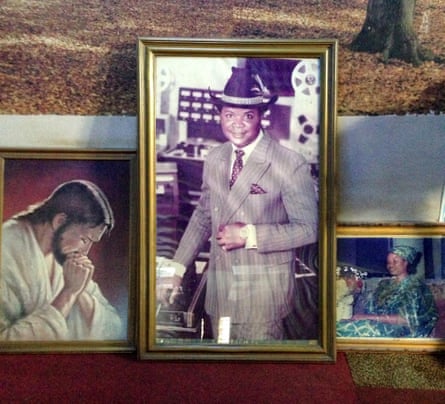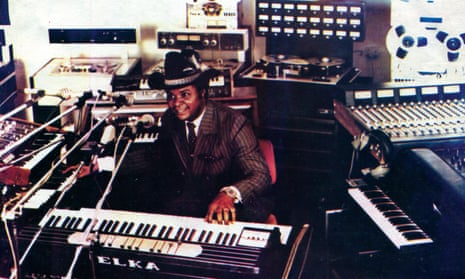William Onyeabor, the Nigerian musician who died in his sleep on Monday at the age of 70, was the recluse’s recluse. For someone like Sixto Rodriguez, subject of the documentary Searching for Sugarman, belated cult stardom was both a vindication and a second chance. But for Onyeabor, growing interest in the music he released during the 70s and 80s cut little ice. Requiring neither money nor attention, he declined to promote Who is William Onyeabor?, the 2013 compilation released on the Luaka Bop label. It says a great deal about his popularity with musicians that the mutating supergroup that toured in his place featured the likes of David Byrne, Damon Albarn, Blood Orange and Hot Chip. Thanks to fans like these, Onyeabor achieved the almost impossible: he experienced a successful comeback with his enigma intact, and without lifting a finger.
The contradictions and elisions in Onyeabor’s life story have never been fully resolved. For decades all that was known for sure was that between 1977 and 1985, he released nine albums of bewilderingly inventive synthesized afrobeat on his own Wilfilms label. Beyond that there were only rumours. Had he really studied cinematography in Moscow? Or law at Oxford? Did the film for which his 1977 debut Crashes in Love was allegedly the soundtrack even exist? How on earth had a DIY auteur in a small Nigerian town made records so unique and forward-looking that they could slot into house music DJ sets decades later? And why did he stop? In the 2014 Noisey documentary Fantastic Man, an acquaintance remarked: “It’s difficult to say exactly who he is … so people just made up things to fit.”
Most of what we know about Onyeabor is thanks to Luaka Bop’s Eric Welles-Nyström and Nigerian-American journalist Uchenna Ikonne, who spent years trying to answer these questions, with virtually no extant information to work from. “It just didn’t make sense,” Welles-Nyström told the Guardian in 2013. “How could someone have done all these things and there be no information available?”
When Welles-Nyström flew to Onyeabor’s hometown of Enugu, where he was known as “the Chief”, the man he met was far from the stereotype of a cult musician. Then in his 60s, Onyeabor was a wealthy, physically fit businessman who lived in a flamboyant three-storey white mansion, apparently unchanged since the 1980s. He was deeply religious, and influential in the local community, with a somewhat paranoid dedication to secrecy that extended to people who knew him. Nobody wanted to get on his bad side. Ikonne told the New York Times that his earlier meeting with Onyeabor was “the toughest ordeal I had ever endured in my life”.
It emerged that Onyeabor was born into a poor family in 1946 but made enough money to travel to Europe to study record manufacturing. By the late 70s he could afford to fund his own recording studio, record label, pressing plant and film company. His business interests, which included a semolina flour mill, led to him being named West African Industrialist of the Year in 1987. He would not, however, be drawn on the existence of the Crashes in Love movie, the exact nature of his Russian connections, or his reasons for making, and then quitting, music. Realising that most of their questions would go unanswered, Luaka Bop changed the working title of their compilation from This Is William Onyeabor to Who Is William Onyeabor?

Onyeabor did, however, allude to a period of suffering, and implied that he disowned his musical career after becoming a born-again Christian. Later, he was ordained as a pastor and, according to friends, privately recorded gospel music. During his first, tense phone conversation with Luaka Bop, prior to Welles-Nyström’s visit, he said: “I only want to speak about God. I don’t want to go back to that time.” Then he hung up.
Onyeabor’s music wasn’t successful beyond Enugu until his 1985 hit When the Going Is Smooth and Good, a playful synth jam that resembles a Nigerian Kraftwerk. Even then, he refused to play live and disliked press attention. It was to be his last record. But interest in his work was renewed in 2001 when the Strut label featured 1978’s Better Change Your Mind, a meandering psychedelic funk record that mocks the arrogance of governments, on its Nigeria 70 compilation. Other tracks emerged sporadically over subsequent years, winning fans including Caribou, Four Tet and Tune-Yards, before the Luaka Bop compilation triggered a full-blown revival. In the Noisey documentary, Damon Albarn said: “This is exactly the kind of music I would love to be able to make.” In 2014, Onyeabor granted his first and only radio interview, to 6Music’s Lauren Laverne, in which he demonstrated a dry sense of humour and said: “I only composed the type of music that would help the world.”
The uncertainty surrounding Onyeabor’s precise methods and motivations makes his music all the more fascinating. His audacious use of synthesizers, which verged on proto-techno, was without precedent in Nigeria, where such equipment was as hard to find as it was to afford. He shunned attention yet presented himself, in lyrics and on record sleeves, as a star. His records were confident, expansive and frequently political, as if he were addressing fans across the world rather than a few people in Enugu. Defying their time and place, they have no context that makes sense, except that of Onyeabor’s own peculiar imagination. At the time of his death he was more popular and influential than he had ever been but he remained to the end one of music’s most insoluble puzzles.

Comments (…)
Sign in or create your Guardian account to join the discussion